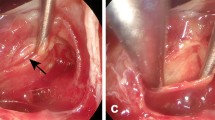Abstract
Purpose
A pituitary pseudocapsule often contains tumor tissue and should be removed for radical resection. It can be used as a surgical plane for more radical resection of the tumor in many cases of pituitary adenomas. We evaluated the advantages and disadvantages of extracapsular en bloc capsulectomy.
Methods
From 1992 until 2011, 1,089 treated patients were grouped according to the resection technique: en bloc capsulectomy, fragmented capsulectomy, or piecemeal resection. Their surgical and endocrinological outcomes and complications were evaluated.
Results
Extracapsular tumor resection was performed in 263 patients; en bloc capsulectomy in 94 patients and fragmented capsulectomy in 169, whereas piecemeal resection was performed in 826. Extracapsular resection was performed more frequently in prolactin- and thyroid-stimulating hormone-secreting tumors. Total resection was more frequently achieved in extracapsular resection and its chance was 100 % when tumors were removed in an en bloc fashion. For the functioning pituitary adenomas, endocrinological remission was achieved in all patients whose tumors were removed in an en bloc fashion and there was no recurrence. Postoperative cerebrospinal fluid (CSF) rhinorrhea developed in 4.2 and 2.7 % in the extracapsular resection group and the piecemeal resection groups, respectively. The chance of postoperative aggravation of pituitary function was not statistically different between groups.
Conclusions
Extracapsular resection is critical for radical tumor resection and endocrinological remission. The removal of a pseudocapsule does not increase the risk of postoperative hypopituitarism nor postoperative CSF rhinorrhea.

Similar content being viewed by others
References
Costello RT (1936) Subclinical adenoma of the pituitary gland. Am J Pathol 12:205–216
Oldfield EH, Vortmeyer AO (2006) Development of a histological pseudocapsule and its use as a surgical capsule in the excision of pituitary tumors. J Neurosurg 104:7–19
Lee EJ, Ahn JY, Noh T, Kim SH, Kim TS (2009) Tumor tissue identification in the pseudocapsule of pituitary adenoma: should the pseudocapsule be removed for total resection of pituitary adenoma? Neurosurgery 64:ons62–ons69
Jagannathan J, Smith R, DeVroom HL, Vortmeyer AO, Stratakis CA, Nieman LK, Oldfield EH (2009) Outcome of using the histological pseudocapsule as a surgical capsule in Cushing disease. J Neurosurg 111:531–539
Kawamata T, Kubo O, Hori T (2005) Surgical removal of growth hormone-secreting pituitary adenomas with intensive microsurgical pseudocapsule resection results in complete remission of acromegaly. Neurosurg Rev 28:201–208
Qu X, Yang J, Sun J, Mou C, Wang G, Han T, Qu YM, Wang M, Xu GM (2011) Transsphenoidal pseudocapsule-based extracapsular resection for pituitary adenomas. Acta Neurochir (Wien) 153:799–806
Ceylan S, Cabuk B, Koc K, Anik I, Vural C (2013) Endoscopic distinction between capsule and pseudocapsule of pituitary adenomas. Acta Neurochir (Wien) 155:1611–1619
Prevedello D, Ebner F, Lara D, Filho L, Otto B, Carrau R (2013) Extracapsular dissection technique with the Cotton Swab for pituitary adenomas through an endoscopic endonasal approach—how I do it. Acta Neurochir (Wien) 155:1629–1632
Ku CR, Kim EH, Oh MC, Lee EJ, Kim SH (2012) Surgical and endocrinological outcomes in the treatment of growth hormone-secreting pituitary adenomas according to the shift of surgical paradigm. Neurosurgery 71:ons192–ons203
Oh MC, Kim EH, Kim SH (2012) Coexistence of intracranial aneurysm in 800 patients with surgically confirmed pituitary adenoma. J Neurosurg 116:942–947
Monteith SJ, Starke RM, Jane JA, Oldfield EH (2012) Use of the histological pseudocapsule in surgery for Cushing disease: rapid postoperative cortisol decline predicting complete tumor resection. J Neurosurg 116:721–727
Laws ER (2006) Pituitary pseudocapsule. J Neurosurg 104:1–2
Cho JM, Ahn JY, Chang JH, Kim SH (2011) Prevention of cerebrospinal fluid rhinorrhea after transsphenoidal surgery by collagen fleece coated with fibrin sealant without autologous tissue graft or postoperative lumbar drainage. Neurosurgery 68:130–136
Qu X, Xu G, Qu Y, Song T (2011) The pseudocapsule surrounding a pituitary adenoma and its clinical significance. J Neurooncol 101:171–178
Acknowledgments
The authors thank Juyoon Park, R.N., M.P.H., O.C.N., Min Kyeong Jang, R.N., Sung Ja Kang, R.N., and Bok Soon Lee, R.N., Pituitary Tumor Clinic and Soo Yeon Choi, M.P.H., Department of Medical Recording for their tremendous effort in performing the endocrinological tests and data acquisition for such a long follow-up duration.
Conflict of interest
The authors report no conflict of interest concerning the materials or methods used in this study and there was no financial support or relationship with any organization.
Author information
Authors and Affiliations
Corresponding author
Electronic supplementary material
Below is the link to the electronic supplementary material.
Video 1. A 38-year-old male patient with a growth hormone-secreting pituitary adenoma. The tumor was removed as one piece with preservation of a normal pituitary gland. A small defect of arachnoid was sealed completely. The tumor was removed completely and biochemical remission was achieved. (MPG 20257 kb)
Video 2. A 49-year-old male patient with a growth hormone-secreting pituitary adenoma. After internal debulking of the tumor, the tumor capsule was carefully dissected from the surrounding normal pituitary gland. The tumor was removed completely without leakage of cerebrospinal fluid and biochemical remission was achieved. (MPG 9694 kb)
Video 3. A 44-year-old male patient with a thyroid-stimulating hormone-secreting pituitary adenoma. In en bloc fashion, the tumor was removed completely. The remaining normal pituitary gland was preserved without leakage of cerebrospinal fluid. After surgery, biochemical remission was also achieved. (MPG 9621 kb)
Video 4. A 51-year-old male patient with an endocrine-inactive pituitary adenoma. As piecemeal resection was impossible because of very hard consistency of the tumor, outer dissection was performed along the tumor capsule. The tumor was completely removed in en bloc fashion. (MPG 14750 kb)
Rights and permissions
About this article
Cite this article
Kim, E.H., Ku, C.R., Lee, E.J. et al. Extracapsular en bloc resection in pituitary adenoma surgery. Pituitary 18, 397–404 (2015). https://doi.org/10.1007/s11102-014-0587-4
Published:
Issue Date:
DOI: https://doi.org/10.1007/s11102-014-0587-4




